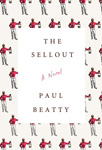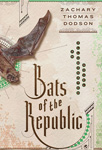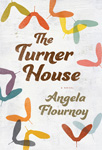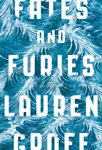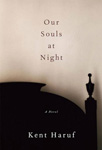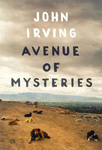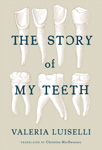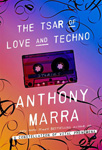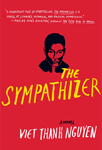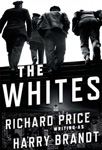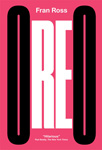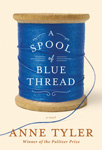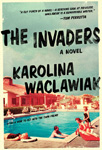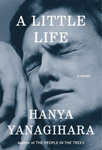by Chris Adrian and Eli Horowitz
Buy it at Powell’s »Maria Bustillos: The dystopian novel Bats of the Republic announces itself from the first instant as being gimmicky as hell, though very handsomely and intricately produced: Its slick, heavy pages contain epistolary fragments written hundreds of years apart, books within books, codes and symbols, inserts and envelopes and trompe l’oeil tissue guards, different colored inks to signify different timelines, mirror writing, handwritten notes, a telegram, maps and drawings, charts, certificates, and forms of all kinds.
Author/designer/illustrator Zachary Thomas Dodson designed this book within an inch of its life, is what I am saying. It’s amazing, just as a made thing. But to read? I went into Bats of the Republic expecting to be manifestly annoyed by all the steampunk gewgaws and furbelows. And found instead an exquisitely complex and exciting book that I will be not only recommending here, but returning to as soon as I am done writing, because I haven’t worked it all out yet and I MUST. With this weirdly enchanting artifact, Dodson has vaulted right into the top rank of speculative fictionalists.
The story is set in alternative versions of Texas that are semi-recognizable, with protagonists who read as various alternative versions of the author. In 1843, Zadock Thomas has been sent on a super-dangerous mission by his frail beloved’s father to deliver a secret letter to General Irion in the middle of the war over Texas. In 2143, his descendant, Zeke Thomas, inhabits an equally dangerous Republic of Texas: Civilization has collapsed and humanity has withdrawn into a walled territory consisting of seven city-states. Zeke stands to inherit the senate seat of his recently deceased grandfather, though his enemies are scheming to prevent him from taking power.
I haven’t gotten anywhere near the bats, nor the Bene Gesserit-like Auspices, a group of female seers whose attempts to control history may or may not bear fruit.
Mention has been made of the book-within-a-book structure of Bats of the Republic, but there are at least four books in there, by my reckoning: the one we’re reading, plus Back on the Nightway, The Sisters Gray, and The City-State, each written by a different author (kind of). Plus another one that is maybe destroyed. In every bit of the text and images there are clues and details that are pertinent to the stories. There are unreliable narrators, too. (That is the part I am kind of stuck in—trying to figure out exactly whom to believe, and when.)
The hidden things in this book are so subtly designed. For example, I realized with a shock that the verso of the faux-tissue-guard page doesn’t exactly match the recto, as a casual reader would assume it must. You can’t possibly look too closely at each page. Pay particular attention to the dustjacket!
While you are having fun sorting all the pieces of the story out, Dodson is exploring many other things, such as Texas and its history, and natural history; how tyranny takes hold in a frightened population; our lack of respect for the natural world; ambition, betrayal, and lust; the helpless protectiveness of parents for their children; archiving, handwriting, and all sorts of things to do with paper and recordkeeping; and love, death, and what may come after or between. Not only in these imagined worlds, but in our own.
Dodson’s prose, broken up into all these epistolary and scholarly and bureaucratic fragments, is for the most part spare and workmanlike. The few passages of startling beauty that have slipped into his pages, arising generally from the pen of the 19th-century naturalist Zadock Thomas, are all the more striking for their scarcity:
It was loping toward me. Before I could take a breath, a beast was on me with fangs and fur and claws. Kicking out with my one good leg and spinning wildly in the dust, I struck out with my broken foot … I have never been fearful of hounds, but the attack was mounted with such speed and ferocity, I began to think I would know what it was to be eaten alive by a growling living thing.
There’s one huge problem with this novel, and that is that it is too damn hard to understand. It asks an enormous amount of the reader, perhaps unreasonably so. You don’t read it so much as mount an investigation that may take weeks.
Ordinarily I prefer my fiction fairly straight, so I figured that Lauren Groff’s Fates and Furies, a hefty novel consisting largely of the minutely detailed dissection of a long marriage, would be right up my street. Romance, duplicity, intellectual sparring, sex, drama, talk of art, elegant interiors, bits of French. Bring it on!
Fates and Furies is the torridly sensual story of a grown-up Mean Girl named Mathilde and the doomed and clueless but radiantly beautiful and magnetic love of her life, the fabulous playwright Lancelot (“Lotto”) Satterwhite. First we see their marriage through his eyes; then through hers. Surprise! They do not look at this thing the same way at all.
The story presents a critique of Lotto’s effortless privilege, how obstacles just seem to melt out of the way of a “golden boy,” when in reality, someone else is always breaking a sweat shoving them aside for him. This critique, however, is offered from a place of equally oblivious privilege. To some extent, that’s deliberate: Groff has sympathy and censure for both her protagonists, though she is definitely more on Mathilde’s side. But it’s all very self-serious, full of portent, dressed up in bits of Greek mythology, and baldly materialist; taste-worshipping, you might say. This book truly loves, for example—especially, its heroine loves—fancy paintings and books, fancy restaurants and clothes.
Not the best food in Paris. The most literary of restaurants, though. She’d dressed in a silver silk sheath, her hair back, her face flushed prettily.
When the waiter came over, Mathilde said only, “It has been a long time since I’ve been in France. I miss the food like a phantom limb.”
His brown eyes sparkled. His moustache gave a leap like a goosed mouse. “I shall bring you our our best dishes,” he promised.
With respect to the style, for example to the moustache that “gave a leap like a goosed mouse” (wtf), I know a lot of people like this kind of prose, but it is not for me. Groff goes straight for the purple, page after page. “This gorgeous girl he’d magicked into wife,” for instance, a phrase repeatedly invoked by other critics as an example of the writer’s skill. I on the other hand gave a leap like a… hrm. Like a French waiter’s moustache. “The hand clutching the curtain was red, ragged, as if it had spent a lifetime among the cold guts of fish.” “The clouds like blackberry jam in the sky, faint double-boiler thunder from the north.” For this reader, at least, clouds are not and can never be even remotely like blackberry jam. It’s distracting, like being attacked by curlicues.
The real problem with Fates and Furies, though, is that the story collapses under the weight of its own melodrama. Now, I love melodrama, and genre fiction in general; I have collected vintage Harlequin romances for years on end, so I should really love this book, and I am sad I didn’t. But even a decent Harlequin romance will have a certain slight self-mocking awareness that the whole business of sex and romance is kind of silly, and comical, whereas Fates and Furies doesn’t have a comical bone in its whole bod; there is a little “dry wit,” but in general the world of the novel is presented as important and true, as deserving of attention and as full of significance as the real world, the one we inhabit.
So the excitingly depraved revelations contained in its denouement recall the wild antics of the late Jackie Collins, but they are dressed up in this very solemn Henry Jamesian manner, and the disconnect is fatal. This book takes itself beyond seriously, and while that is not a crime, it is not to my taste.
I feel kind of bad because I am clearly the short straw in the “Lotto” of this tournament, so far as Groff is concerned; even the name “Lancelot Satterwhite” caused me to snort right on contact. But people love this book, really love it—the president, even, loves this book, apparently.
Two ambitious, imaginative, complex novels, both loaded with drama and improbable incidents and crazy people. One of them gently asking you, by means of a series of absorbing textual and graphic puzzles, to be mindful of human fallibility repeating itself, and of the fragility and beauty of the earth; the other, an interesting but ultimately narcissistic tale of art and marriage.
There’s no contest here for me. The bats fly forth into the next round.
Match Commentary
By Kevin Guilfoile & John Warner
John: Whelp, this seals it. I am officially the worst prognosticator in the history of the ToB. Prior to the tourney I put A Little Life and Fates and Furies as the 1 and 1a favorites to win the whole thing and here it is, day one and Fates goes down.
Kevin: Fates and Furies was my favorite novel of 2015, John. It’s also true that I might be practically its perfect reader.
Lauren and I grew up on the same street, on the same lake, in the same small town, maybe a hundred yards from each other. She was a decade younger than me, so we didn’t know each other then, but I know exactly the house she lived in, and the route she walked to school (where we sat in the same classrooms and had nearly all the same teachers). I know the kind of pizza she ate, and even the guy who made it (What’s up Johnny!). When a character in her novels goes to Stewart’s for ice cream, I know exactly the Stewart’s she means. When that same character drives to a nearby village to go for a swim in the public gym, I know exactly the gym she means. You and I know a lot of writers and it is always a smile when you come across a passage in one of their books that reveals something about the author that you already knew. I don’t know Lauren nearly as well as I know other novelists, but I have that experience more with her fiction than I do with anyone else’s. There is something unique about sharing the place of your childhood that creates an almost telepathic bond. It’s a shorthand you only share with people who understand the map of your youth.
But that isn’t why I loved this book so much.
I was captivated by it from the start, but the way the story flips over and the narrative starts tumbling rapidly downhill at the midway point is a marvel of novelistic architecture. It begins as the sum of a number of literary clichés (whirlwind romance + husband’s family doesn’t like the new wife + tortured writer) and, in fact, the first half of this story would be a pretty conventional literary novella on its own. Then Lauren spends the rest of the book—the other side of the equation—deconstructing those clichés pretty masterfully.
Judge Bustillos pulls a few lines from the novel as evidence of Groff’s purplish prose (although she acknowledges the degree to which Lauren’s writing has been praised in most quarters). I am generally against cherry-picking lines to showcase bad (or good) writing, even though I catch myself doing it, as well—it’s an irresistible rabbit in the critic’s bag of tricks. But I think this is an example that illustrates why that practice can be misleading. Throughout the novel, Lauren makes some curious choices with regard to word choice and syntax, to be sure, but it is all in the service of a voice I found entirely hypnotic. If you don’t fall under its spell, you may react the way Judge Bustillos did, but I was completely in its thrall. If the last words on the last page of this book were, “Kevin, you are now a chicken,” I would be writing this commentary in scratches on the floor of an overcrowded Tyson killing floor.
Lauren also does something with point of view that I was really taken with. Most of this story is written in a third-person POV attached to one or other of the characters. Occasionally, however, she will slip into omniscience, only for a few words, usually to correct something that one of the characters is wrongly (or perhaps deceptively) saying or thinking. (Forget that crap I said before, I’m cherry-picking an example):
“I mean, of course, wife in the genderless sense of helpmeet,” Lancelot said. “There are male wives. When I was an actor, I was so underemployed that I basically did all the housework myself while Mathilde earned the dough. [He did the dishes; that part was true.] … ”
The proximate function of this device is to keep reminding us of the unreliability of our narrators, and there are no doubt precedents for it going back to the Greek chorus (which folds neatly into the dramaturgical motifs throughout the book), but playing loose with POV is a dangerous game for a writer and I can’t think of many novelists who have pulled it off as originally and effectively as Groff has here.
John: I read Fates and Furies on a cross-country flight. There are no higher stakes for a book than being my airplane reading. If the book is no good, I no longer even have SkyMall for a distraction. It is whatever I’ve chosen to read or nothing, and I enjoyed Fates so thoroughly that I would’ve been happy to bypass San Francisco and go on to Hawaii just so I had enough time to get through the last 80 pages, after which I would sit back and have a good think about the book for the rest of the flight.
I agree that the purple prose charge seems unfair. Of course, I’m saying that because I love the book and the writing, so I’m inclined to defend it from the standpoint of my conclusion, rather than as a judicious weighing of the evidence. But for all of Groff’s verbal filigree, it never felt like she had anything less than total control, including the use of the “Greek Chorus.” There is another very popular book in our tournament to which the purple prose charge could stick, but I disagree with it here.
Kevin: I read Bats of the Republic in ARC form about a year ago. The advance copy was a paperback, printed in black and white. Unlike the finished hardcover, there was no MacGuffin envelope tucked into the binding at the end—its contents were presented as just more pages in the book. (I won’t say more about this, but those who have read the novel will understand why that is problematic.) When I finished I thought it was very enjoyable, and also that I didn’t really understand it entirely. But the way the book was described in accompanying material made it clear that the final version was going to be ambitious in thrilling ways. (As Judge Bustillos describes, you will get more pleasure from simply holding this book in your hands than from any other published this year.)
Months later, a friend of mine who is a firefighter was looking for something to read during down time at the station. I thought Bats might be something he’d dig, and so I recommended it. He came over my house a few days later, hardcover in hand, and wanted to talk about it. As he spoke I realized how much I had missed reading it in ARC form as I did. Just from that discussion (and a subsequent rereading of several sections and especially the ending) my estimation of the book increased tremendously.
Like Judge Bustillos, I think there is still a great deal I have missed, but the parts I don’t entirely understand have been fun and interesting to contemplate (and discuss) in the months since. Bats of the Republic is a book that would almost certainly be better digested on a subsequent reading, and there is plenty of textual evidence that Dodson actually wants you to go back and start the book over again. I will definitely do that someday (I now have a hardcover and will likely keep it forever, it’s so beautiful), but for now I will enjoy following the reactions of smart people like Judge Bustillos as they try to unpack it.
John: Bats is a beautiful artifact and I took a real pleasure in using the ribbon to mark my place every time I left off from the text. I have to believe that reading it in ARC form without the benefit of the full extent of Dodson’s design and packaging would have been a greatly diminished experience. As I read, I really, really, really wanted to know what was in that envelope, simply for the fact that it was sealed in an envelope and I was commanded not to look until the right time.
Despite my admiration for the design and packaging, and that tantalizing envelope, for me, Bats was meh. Not for a second did I feel emotionally invested in any of the characters or their fates. It’s a fun adventure yarn, and some of the nested metatextual stories within stories are intriguing, but I’m going to suggest there’s a lot less there, there, than Judge Bustillos perceives after her initial reading. The Möbius design theme that runs through the book is likely to be the experience if one goes looking for deeper connections: an endless loop over the same ground. I think the interesting novel inside the amazing packaging is more illusory than real. This aura of mystery plays to the novel’s advantage in that it can be different things to different people, but when I reflect back on the actual reading experience, I grieve for the loss of Fates from our tournament.
I can only hope it returns as a Zombie.
Kevin: Losing Fates is a crushing, personal blow for me on Day One (or Day 1A), but my consolation prize (as I hopefully wait for Lauren’s potential return in the Zombies) will be further discussion about Bats of the Republic. I understand what you are saying about it. I, too, find myself rolling my eyes at people who think a book must be good because they don’t understand it. To be clear, Bats isn’t some obtuse, impenetrable read, and even on the surface, I found myself engaged in the story. I just don’t feel like I have fully synthesized all the elements here. It’s thrilling the way a half-finished puzzle is. Of course a puzzle only thrills if you have confidence in the puzzle constructor. Your read of the novel didn’t provide you with that faith, but Judge Bustillos and I felt more reassured. When I get to my re-read I will report back to you and let you know if I still have the same religion.
Brad Listi judges tomorrow’s matchup, which pits one of the most celebrated debuts of 2015, Viet Thanh Nguyen’s The Sympathizer, against an almost forgotten debut originally published some 40 years ago, Fran Ross’s Oreo.

The official 2016 Tournament of Books T-Shirt by book designer Janet Hansen. Order yours!



